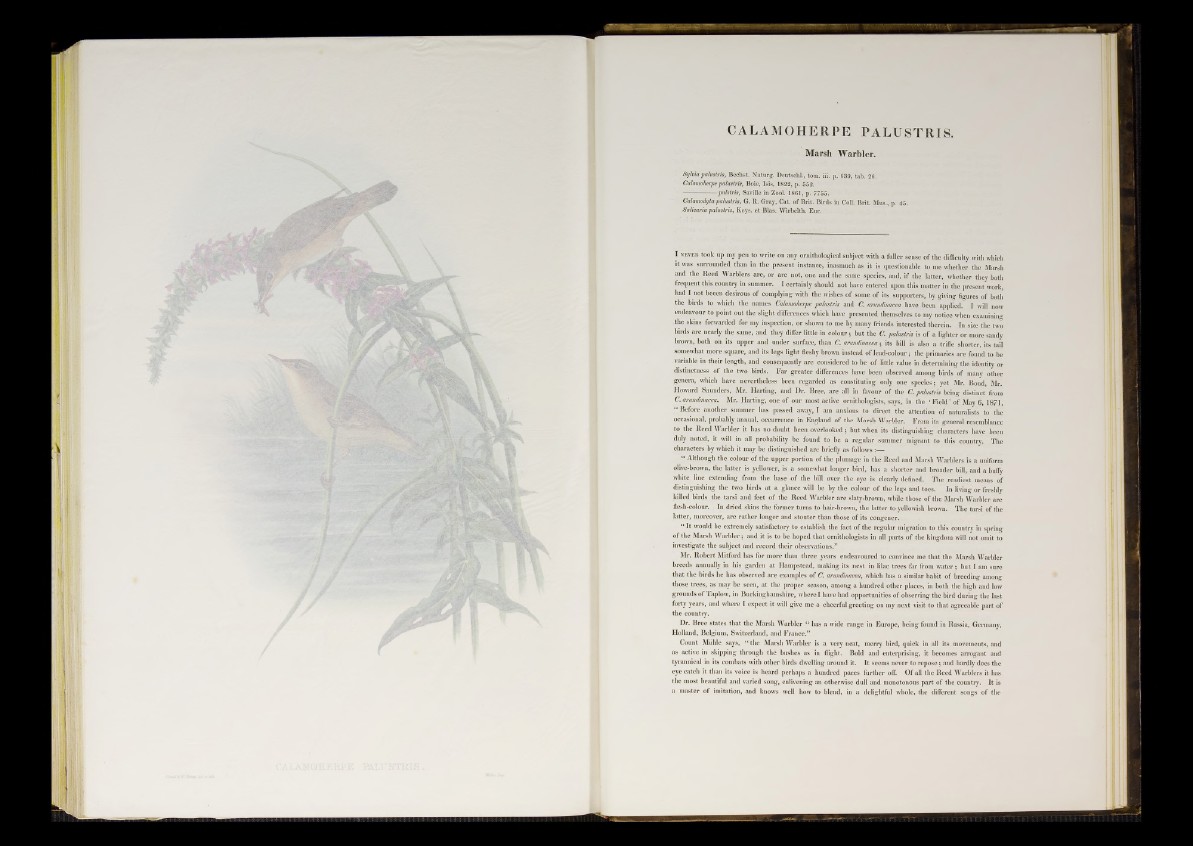
Marsh Warbler.
Sylvia palustris, Bechst. Naturg. Deutschi., tom. iii. p. 639, tab. 26.
Calamoherpe palustris, Boie, Isis, 1822, p. 552. '
pulstris, Saville in Zool. 1861, p. 7755.
Calamodyta palustris, G. R. Gray, Cat. of Brit. Birds in Coll. Brit. Mus., p. 45.
Salicaria palustris, Keys, et Blas. Wirbelth. Eur.
I never took up ray pen to write on any ornithological subject with a fuller sense of the difficulty with which
it was surrounded than in the present instance, inasmuch as it is questionable to me whether the Marsh
and the Reed Warblers are, or are not, one and the same species, and, if the latter, whether they both
frequent this country in summer. I certainly should not have entered upon this matter in the present work,
had I not beeen desirous of complying with the wishes of some of its supporters, by giving figures of both
the birds to which the names Calamoherpe palustris and C. arundinacea have been applied. I will now
endeavour to point out the slight differences which have presented themselves to my notice when examining
the skins forwarded for my inspection, or shown to me by. many friends interested therein. In size the two
birds are nearly the same, and they differ little in colour; but the C. palustris is of a lighter or more sandy
brown, both on its upper and under surface, than C. arundinacea; its bill is also a trifle shorter, its tail
somewhat more square, and its legs light fleshy brown instead of lead-colour; the primaries are found to be
variable in their length, and consequently are considered to be of little value in determining the identity or
distinctness of the two birds. Far greater differences have been observed among birds of many other
genera, which have nevertheless been regarded as constituting only one species; yet Mr. Bond, Mr.
Howard Saunders, Mr. Harting, and Dr. Bree, are all in favour of the C. palustris being distinct from
C. arundinacea. Mr. Harting, one of our most active ornithologists, says, in the ‘ Field’ of May 6, 1871,
“ Before another summer has passed away, I am anxious to direct the attention of naturalists to the
occasional, probably annual, occurrence in England of the Marsh Warbler. From its general resemblance
to the Reed Warbler it has no doubt been overlooked; but when its distinguishing characters have been
duly noted, it will in all probability be found to be a regular summer migrant to this country. The
characters by which it may be distinguished are briefly as follows :— V
“ Although the colour of the upper portion of the plumage in the Reed and Marsh Warblers is a uniform
olive-brown, the latter is yellower, is a somewhat longer bird, has a shorter and broader bill, and a huffy
white line extending from the base of the bill over the eye is clearly defined. The readiest means of
distinguishing the two birds at a glance will be by the colour of the legs and toes. In living or freshly
killed birds the tarsi and feet of the Reed Warbler are slaty-brown, while those of the Marsh Warbler are
flesh-colour. In dried skins the former turns to hair-brown, the latter to yellowish brown. The tarsi of the
latter, moreover, are rather longer and stouter than those of its congener.
“ It would be extremely satisfactory to establish the fact of the regular migration to this country in spring
of the Marsh Warbler ; and it is to be hoped that ornithologists in all parts o f the kingdom will not omit to
investigate the subject and record their observations.”
Mr. Robert Mitford has for more than three years endeavoured to convince me that the Marsh Warbler
breeds annually in his garden at Hampstead, making its nest in lilac trees far from water ; but I am sure
that the birds he has observed are examples of C. arundinacea, which has a similar habit of breeding among
those trees, as may be seen, at the proper season, among a hundred other places, in both the high and low
grounds of Taplow, in Buckinghamshire, where I have had opportunities o f observing the bird during the last
forty years, and where I expect it will give me a cheerful greeting on my next visit to that agreeable part of
the country.
Dr. Bree states that the Marsh Warbler “ has a wide range in Europe, being found in Russia, Germany,
Holland, Belgium, Switzerland, and France.”
Count Miihle says, “ the Marsh Warbler is a very neat, merry bird, quick in all its movements, and
as active in skipping through the bushes as in flight. Bold and enterprising, it becomes arrogant and
tyrannical in its combats with other birds dwelling around it. It seems never to repose; and hardly does the
eye catch it than its voice is heard perhaps a hundred paces further off. Of all the Reed Warblers it has
the most beautiful and varied song, enlivening an otherwise dull and monotonous part of the country. It is
a master of imitation, and knows well how to blend, in a delightful whole, the different songs of the